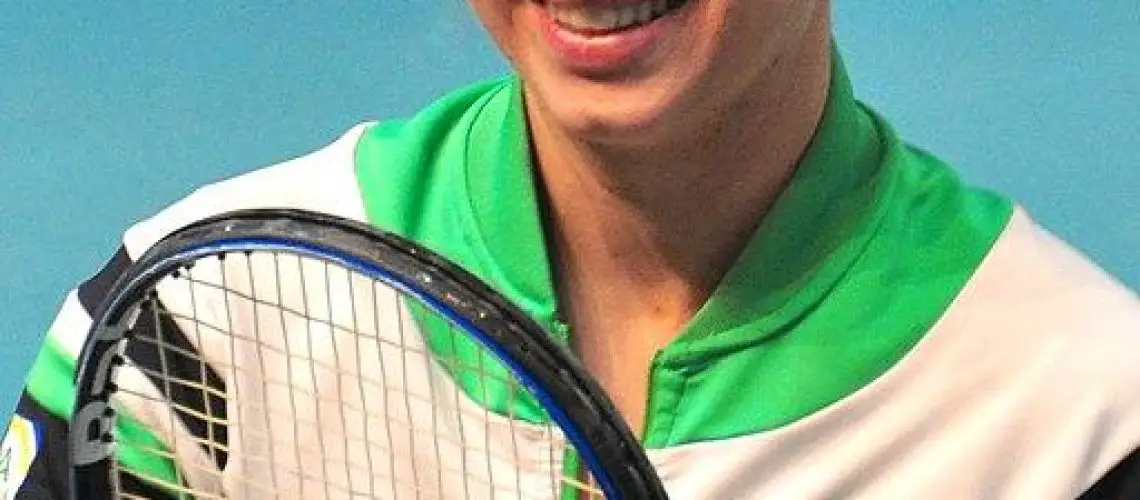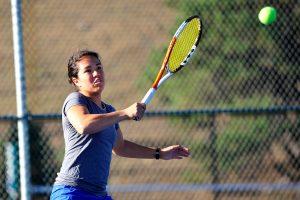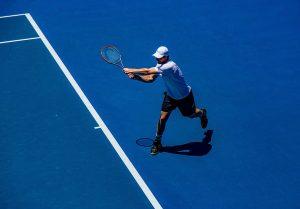We may earn money or products from the companies mentioned in this post.
What Is A Backhand In Tennis?

In the world of tennis, the backhand is a crucial stroke that allows players to hit the ball on their non-dominant side It is an essential skill that every tennis player must master in order to excel on the court There are two main types of backhands: the single-handed backhand and the double-handed backhand Let’s take a closer look at each of them
1 Single-handed backhand
The single-handed backhand is a classic technique where the player uses only one hand to grip and swing the racket This style requires greater strength and wrist flexibility compared to its counterpart, but it offers several advantages One major benefit of the single-handed backhand is its versatility, as it allows for more precise control and finesse shots It also enables players to generate more power and spin by utilizing a longer swing arc
2 Double-handed backhand
The double-handed backhand, as its name suggests, involves gripping the racket with both hands during the shot This technique provides players with added stability and control due to the extra point of contact with the racket The double-handed grip also allows for better weight transfer and improved consistency in hitting cross-court shots Additionally, it can be advantageous for players who struggle with generating enough power on their own
Importance of the Backhand in Tennis

The backhand stroke plays a vital role in a player’s overall performance on the tennis court, offering both offensive and defensive capabilities that can make or break a match
1 Offensive capabilities
A strong backhand empowers players to go on the offensive by delivering powerful shots that can surprise opponents and force errors or weak returns With proper technique and timing, players can hit winners down the line or cross-court, putting their opponents under immense pressure The backhand also enables players to approach the net with confidence, setting up opportunities for volleys and smashes
2 Defensive capabilities
On the defensive end, a reliable backhand allows players to effectively return shots that are directed towards their non-dominant side It provides stability and control when facing aggressive shots from opponents and helps in maintaining rallies With a solid backhand, players can counterattack challenging balls and keep themselves in the point, preventing their opponents from gaining an advantage
In conclusion, the backhand is a crucial stroke in tennis that requires skill, technique, and practice to master Whether it’s the single-handed or double-handed variation, a strong backhand can be both an offensive weapon and a defensive shield on the court
Mechanics of a Proper Backhand Technique

Mastering the backhand technique in tennis is crucial for players who want to excel on the court It requires a combination of footwork, positioning, and swing mechanics Let’s dive into the key components of a proper backhand technique
Footwork and Positioning
1 Ready Position:
The first step towards executing a solid backhand is to establish a strong ready position This means being balanced, with your feet shoulder-width apart, knees slightly bent, and weight evenly distributed on both feet
2 Split Step and Pivot Turn:
To be able to move quickly and efficiently during the stroke, it’s important to incorporate the split step and pivot turn into your footwork The split step involves hopping off both feet just as your opponent hits the ball, while the pivot turn helps you rotate your body sideways to prepare for the backhand shot
Swing Mechanics
1 Backswing:
The backswing is where you generate power and set yourself up for an effective shot
a) Single-handed backswing technique:
If you’re using a single-handed grip on your backhand, start by bringing your non-dominant hand across your body as you rotate your shoulders and hips This will help load up energy for an explosive swing
b) Double-handed backswing technique:
If you prefer a double-handed grip, both hands should work together during the backswing As you rotate your shoulders and hips, use your non-dominant hand to assist in pulling the racket backward while maintaining control
2 Contact Point with the Ball:
Your contact point is the key to achieving power and control in your backhand shot
a) Optimal contact zone for power and control:
The ideal contact zone for a powerful backhand is slightly in front of your body, allowing you to hit the ball at waist height This position gives you better control over the shot and enables you to generate maximum power
b) Flat, topspin, and slice variations:
Depending on the situation, you can vary the type of shot by adjusting your racket face angle at the moment of contact A flat backhand will result from a square racket face, while topspin can be achieved by brushing up on the ball with a slightly closed racket face On the other hand, a slice backhand requires an open racket face and a slicing motion through the ball
3 Follow-through and Extension:
To complete your backhand stroke effectively, make sure to follow through with your swing Extend your arm fully towards your target as you release energy into the shot This extension will help increase accuracy and add extra power to your backhand
Common Errors and How to Fix Them
Incorrect grip type or placement
One of the most common errors in tennis is using the wrong grip for your backhand strokes Whether you’re playing a single-handed or double-handed backhand, having the correct grip can make a significant difference in your shot quality
For a single-handed backhand, the Eastern backhand grip is recommended This grip allows for better control and maneuverability of the racket, enabling you to generate more power and accuracy in your shots
On the other hand, if you prefer a double-handed backhand, the Continental grip is what you should use This grip involves placing both hands close together on the handle with both palms facing each other It provides stability and strength, allowing you to hit powerful and consistent shots
Additionally, there’s also a two-handed hybrid grip option In this case, you would use a non-dominant hand eastern forehand grip (similar to how you hold it for a forehand shot) while maintaining a dominant hand continental grip This combination gives you increased control and versatility in your backhand strokes
Late timing or poor contact point
Another common error that affects shot quality is late timing or poor contact point during ball impact When your timing is off or if you consistently make contact with the ball too early or too late, it can greatly affect your shot’s power and accuracy
To improve your timing, focusing on footwork is crucial Proper footwork ensures that you are in an optimal position to strike the ball at its ideal height and location Work on moving towards the ball early and positioning yourself well before making contact
In addition to footwork adjustments, incorporating practice drills into your training routine can help improve contact point consistency These drills can involve hitting against a wall or using specific targets on court to work on hitting balls at different heights and angles
By addressing these common errors through proper grip selection, footwork adjustments, and focused practice drills, you can significantly enhance your tennis game Remember, practice makes perfect, so don’t be afraid to put in the time and effort to refine your technique and improve your overall performance on the court
Strategies, Drills, And Tips For Improving Your Backhand

When it comes to improving your backhand in tennis, having effective strategies in place is crucial One key strategy is utilizing crosscourt shots to open up the court By hitting the ball diagonally across the net, you force your opponent to cover more ground and create better angles for yourself
In addition to crosscourt shots, down-the-line shots are another valuable tool in your backhand arsenal These shots allow you to change direction quickly and catch your opponent off guard Mastering this technique will give you greater control over the flow of the game
To keep opponents guessing and make your backhand even more formidable, mix up the pace, spin, and depth of your shots Varying these elements will make it harder for your opponents to anticipate and respond effectively
Effective drills for developing your backhand
- Singles drills: Crosscourt rallies are a fantastic way to improve both consistency and accuracy with your backhand Another useful drill is practicing down-the-line targets, which helps sharpen your ability to hit those crucial directional shots
- Doubles drills: Alley rallies provide an excellent opportunity for refining your backhand strokes while working on teamwork with a partner Additionally, crosscourt volleys can enhance both your volleys and overall control of the ball
- Conditioning drills: Shadow swings are an effective exercise that allows you to focus on perfecting your form without worrying about hitting an actual ball Core strength exercises such as planks and Russian twists can also help improve stability and power in your backhand
Professional player examples and inspiration
If you’re looking for inspiration or role models when it comes to backhands, consider studying single-handed backhand players like Stan Wawrinka and Justine Henin They showcase the elegance and precision that can be achieved with this technique
On the other hand, double-handed backhand players like Novak Djokovic and Serena Williams demonstrate the raw power and versatility of a two-handed grip Analyzing their techniques can provide valuable insights for developing your own backhand game
Additional tips for maximizing your backhand potential
- Regular practice and repetition are key to improving any aspect of your tennis game, including your backhand Dedicate specific practice sessions to focus solely on this stroke to see significant progress over time
- Mental focus is just as important as physical training when it comes to enhancing your backhand Utilize visualization techniques to imagine yourself successfully executing each shot, helping build confidence and muscle memory
- Finding the right equipment, such as racquets and strings, is essential for optimizing your backhand performance Experiment with different options to find what suits your style best, allowing you to generate more power or control depending on your needs
Useful Links

How To Get Topspin On The Two Handed Backhand
tennis: forehand and backhand – Students
Roger Federer Backhand Analysis
Tennis grips
5 Drills That Will Help You Nail The Tennis Backhand
A comparative study of backhand strokes in tennis among …
How-to: Tennis Backhand
Adding spin in two-handed backhand for beginner players
The one- and two-handed backhands in tennis
A Scientific Analysis of the Backhand Stroke in Tennis
Tennis Backhand Tip: How To Handle The High Backhand
What is a backhand in tennis?
Step 9 Backhand
“Forehand is your sword, backhand is your shield” says …
Two-handed Backhand






